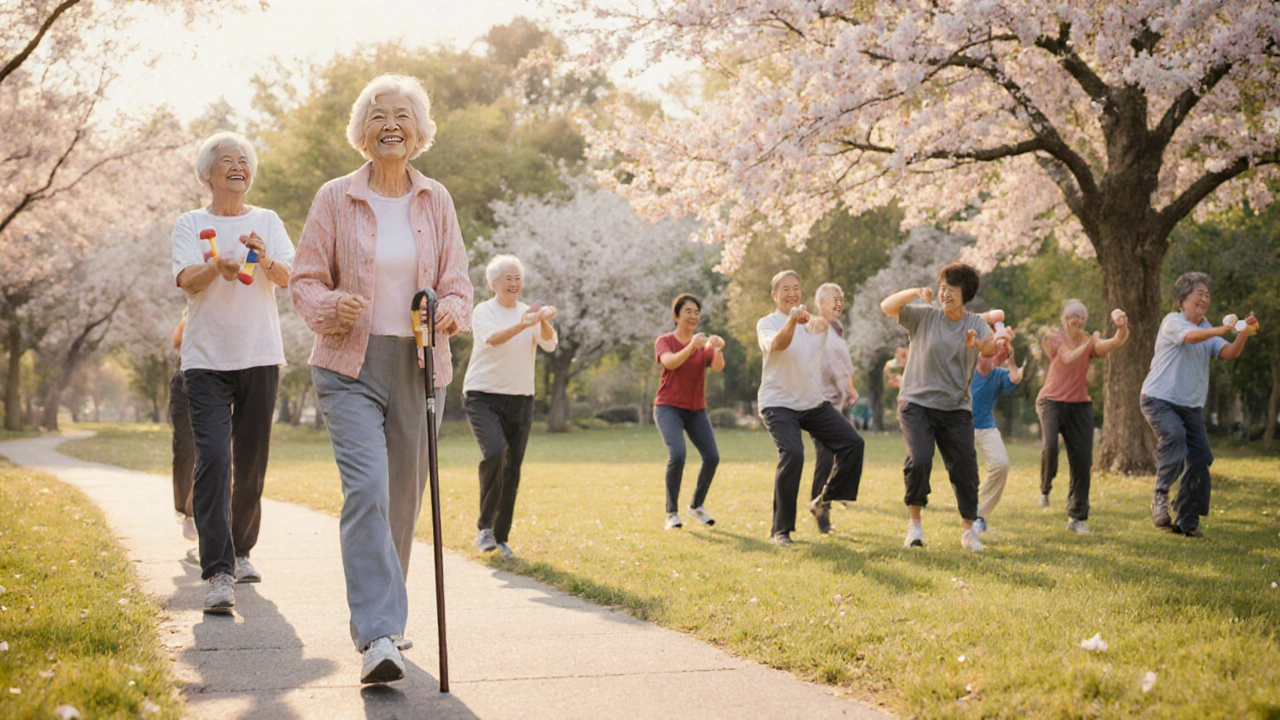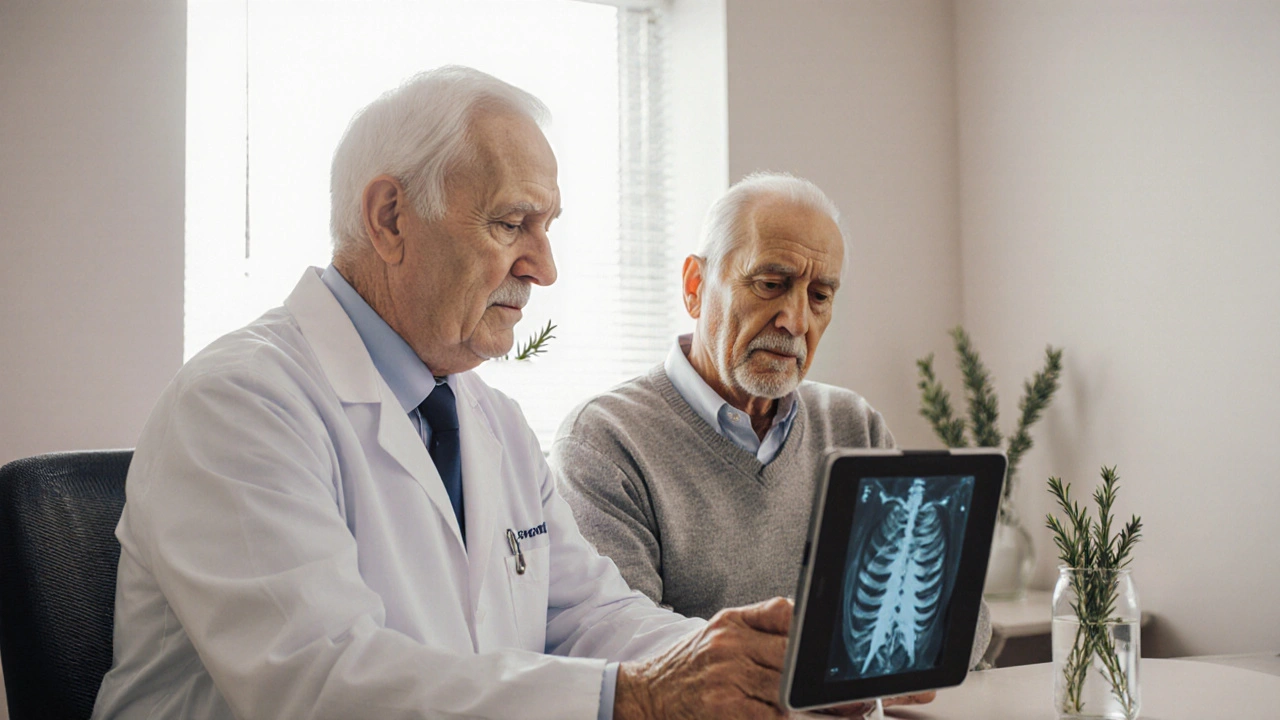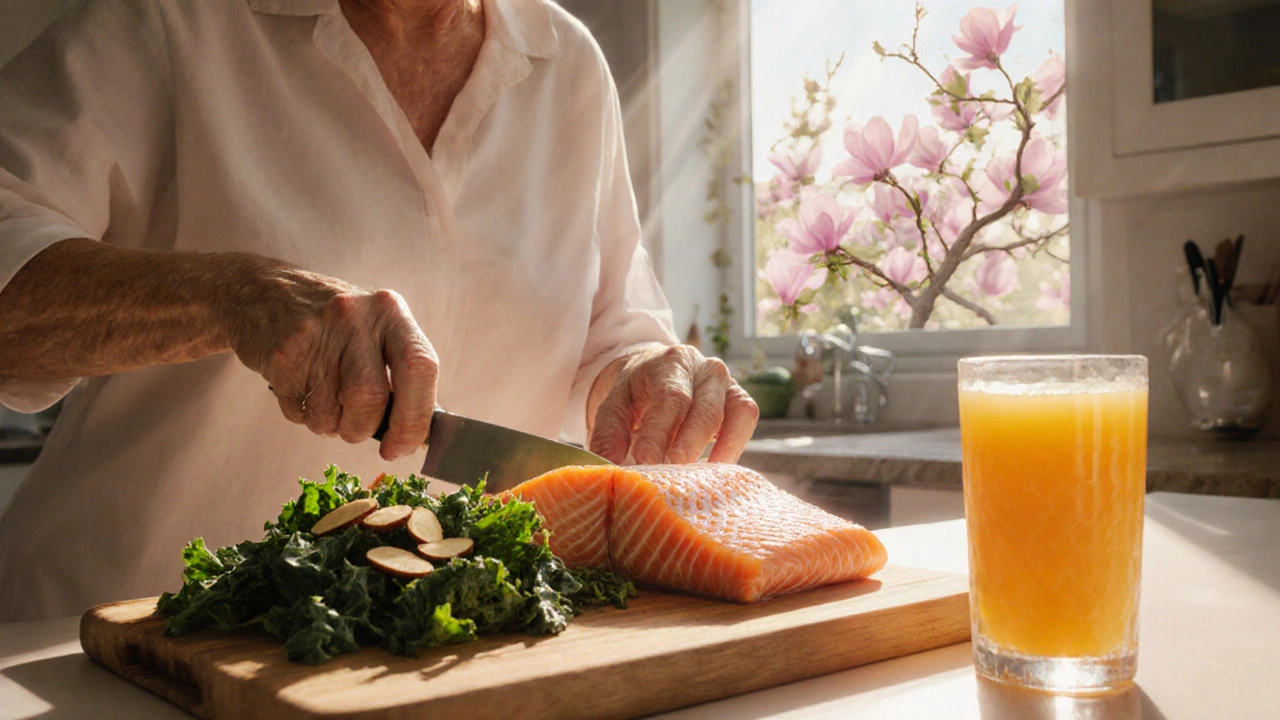Osteoporosis is a chronic condition that weakens bones, making them porous and prone to breakage. As the population ages, the link between bone fractures and everyday activities becomes a public‑health concern. This guide shows you practical steps to keep your skeleton strong and avoid the pain, cost, and loss of independence that come with broken bones.
Quick Takeaways
- Get 1,200mg of calcium daily from food first, supplement only if needed.
- Aim for 800-1,000IU of vitamin D each day to maximise calcium absorption.
- Do weight‑bearing exercises at least three times a week - think brisk walking, stair climbing, or resistance bands.
- Schedule a bone‑density test (DXA scan) after age 50 for women, 60 for men, or earlier if you have risk factors.
- Consider medication such as bisphosphonates only after a doctor confirms low bone density.
Understanding the Mechanics: Why Bones Break
Bone is living tissue that constantly remodels itself. When the breakdown (resorption) outpaces the rebuilding (formation), density drops and the skeleton becomes fragile. Several factors accelerate this imbalance:
- Age - after 30, bone loss speeds up gradually.
- Gender - women lose bone faster post‑menopause due to estrogen decline.
- Lifestyle - smoking, excessive alcohol, and sedentary habits all shave off bone mass.
- Nutrient gaps - insufficient calcium or vitamin D leaves the skeleton under‑mineralised.
When a bone’s structural integrity is compromised, even a minor stumble can cause a fracture, especially in the hip, spine, or wrist.
Key Players in Bone Health
Below are the eight core entities you’ll hear about throughout this article. Their definitions appear once, marked up for search engines.
- Calcium - the primary mineral that gives bones their hardness. Recommended intake: 1,200mg/day for adults over 50.
- Vitamin D - the vitamin that tells your gut to absorb calcium. Aim for 800-1,000IU/day.
- DXA scan - a dual‑energy X‑ray absorptiometry test that measures bone mineral density (BMD) with a tiny radiation dose.
- Bisphosphonate - a class of prescription drugs (e.g., alendronate) that slow bone resorption.
- Weight‑bearing exercise - activities that force you to work against gravity, stimulating bone formation.
- Fall prevention - strategies like home safety checks and balance training that reduce the chance of a stumble.
- Hormonal changes - especially the drop in estrogen during menopause, a major driver of bone loss.
- Nutrient‑rich diet - a balanced eating plan that supplies calcium, vitamin D, protein, and magnesium.
Building a Bone‑Friendly Diet
Food first, supplements second. Here’s a realistic 7‑day menu snapshot that hits the calcium and vitamin D targets without feeling like a pharmacy.
- Breakfast: fortified oatmeal (300mg calcium) with a splash of orange juice fortified with vitamin D.
- Snack: a handful of almonds (75mg calcium) and a small piece of cheese (200mg calcium).
- Lunch: kale salad with sardines (250mg calcium, 400IU vitamin D) and a drizzle of olive oil.
- Dinner: grilled salmon (500IU vitamin D) with a side of steamed broccoli (60mg calcium) and quinoa.
- Evening snack: Greek yogurt (150mg calcium) topped with berries.
If you struggle to reach 1,200mg, a calcium supplement providing 500mg per tablet can fill the gap. Choose a chewable or liquid form if you have digestive issues.
Vitamin D: The Unsung Hero
Without enough vitamin D, up to 50% of dietary calcium may be wasted. Sunlight is the cheapest source - 10‑15 minutes of midday sun on face and arms two to three times a week often suffices for people living in the UK. If you’re indoors year‑round, a daily supplement of 800-1,000IU is safe and effective.

Exercise Prescription that Actually Works
Not all workouts are equal for bone health. Research shows that high‑impact, weight‑bearing activities raise BMD by roughly 1‑2% per year. Here’s a practical weekly plan:
- Monday: 30‑minute brisk walk (incline if possible).
- Wednesday: 20 minutes of stair climbing or step‑mill.
- Friday: Resistance band routine - 3 sets of 12 squats, lunges, and overhead presses.
- Saturday: Light yoga focused on balance (helps fall prevention).
Start slowly; even a 10‑minute walk counts. Consistency beats intensity for long‑term bone gain.
Screening: When to Get a DXA Scan
The DXA scan is the gold standard for detecting low bone density before fractures happen. The UK National Osteoporosis Guideline recommends:
- Women ≥65years - routine scan.
- Men ≥70years - routine scan.
- Anyone <65years with risk factors (e.g., long‑term steroids, family history) - consider earlier testing.
The test yields a T‑score. A score of -2.5 or lower confirms osteoporosis; -1 to -2.5 signals osteopenia, a warning stage where intervention can reverse the trend.
Medication: When Lifestyle Isn’t Enough
For many, diet and exercise curb bone loss. If your DXA shows osteoporosis, doctors may prescribe a bisphosphonate. These drugs bind to bone surfaces and slow the cells that break down bone. Common side effects include mild stomach irritation, so take them with a full glass of water and stay upright for 30minutes.
Newer options like denosumab or selective estrogen receptor modulators (SERMs) exist, but they’re usually reserved for people who can’t tolerate bisphosphonates.
Fall Prevention: The Last Line of Defense
Even a healthy skeleton can crack under a bad fall. Simple home tweaks cut fall risk dramatically:
- Remove loose rugs and install non‑slip mats in the bathroom.
- Keep walkways clear of cords and pet toys.
- Install grab bars next to the toilet and in the shower.
- Ensure adequate lighting - night‑lights in hallways help.
- Wear sensible shoes with low heels and good tread.
Balance‑training exercises (e.g., single‑leg stands) improve proprioception and can lower fall incidence by up to 30%.
Putting It All Together: A 30‑Day Action Plan
- Day1‑7: Record your current calcium and vitamin D intake. Add a fortified food or supplement to meet targets.
- Day8‑14: Begin the weekly exercise schedule. Log each session.
- Day15‑21: Conduct a home safety audit - fix one fall‑hazard each day.
- Day22‑28: Book a DXA scan if you’re in a screening age group or have risk factors.
- Day29‑30: Review results with your GP. Discuss whether medication is needed.
Stick to the plan, and you’ll have built a solid foundation for stronger bones and fewer fractures.
| Source | Calcium (mg per serving) | Vitamin D (IU per serving) | Absorbability* |
|---|---|---|---|
| Milk (250ml) | 300 | 100 | High |
| Yogurt (150g) | 200 | 80 | High |
| Cheese (30g) | 210 | 40 | Moderate |
| Calcium carbonate tablet (500mg) | 500 | 0 | Low‑to‑moderate (needs stomach acid) |
| Calcium citrate tablet (250mg) | 250 | 0 | Higher (works with reduced acid) |
*Absorbability reflects how much calcium the body typically utilizes from the source.

Frequently Asked Questions
How often should I get a bone‑density test?
Women should be screened at age 65 and men at 70, unless they have risk factors like long‑term steroid use, a family history of fractures, or early menopause. In those cases, testing can start as early as 40‑50.
Can I get enough vitamin D from food alone?
Few foods naturally contain high vitamin D. Fatty fish (salmon, mackerel) and fortified dairy or plant milks provide the most. Most UK adults still need a modest supplement, especially in winter.
Are bisphosphonates safe for long‑term use?
They are generally safe when taken as prescribed. Rare side effects include jaw osteonecrosis and atypical femur fractures, which are why doctors monitor bone density every 2‑3 years.
What’s the best type of exercise for my hips?
Hip‑strengthening moves like side‑lying leg lifts, glute bridges, and low‑impact aerobics (e.g., cycling) load the hip joint and stimulate bone formation.
How can I tell if I’m at risk for falls?
Ask yourself: Do I feel unsteady when standing on one foot? Do I use a cane or walker? Do I have vision problems or take medications that cause dizziness? If yes, a fall‑risk assessment with a physiotherapist is wise.


Anna-Lisa Hagley
September 27, 2025 AT 23:55While the article enumerates sensible recommendations, it neglects the socioeconomic gradient that underlies calcium intake, a factor that cannot be ignored when assessing fracture risk across populations.
A Walton Smith
October 7, 2025 AT 06:09Looks fine but could use less bullet points
Theunis Oliphant
October 16, 2025 AT 12:22One must appreciate that the prescribed calcium dosage-1,200 mg per day-aligns with the Institute of Medicine's RDA, yet the text omits the crucial distinction between elemental calcium and calcium salts, a lapse that may confound the lay reader.
India Digerida Para Occidente
October 25, 2025 AT 18:35The guide does an admirable job highlighting weight‑bearing exercise, but let us not forget that balance training, such as Tai Chi, is equally vital for fall prevention; integrating both modalities will yield a synergistic protective effect on skeletal integrity.
Andrew Stevenson
November 3, 2025 AT 23:49The recommendations presented here constitute a comprehensive osteoporotic prophylaxis protocol, integrating nutritional biochemistry, biomechanics, and clinical screening pathways. First, the emphasis on achieving a daily calcium intake of 1,200 mg reflects the consensus of the National Osteoporosis Foundation and aligns with the concept of calcium homeostasis mediated by parathyroid hormone feedback loops. Second, the stipulated 800–1,000 IU of vitamin D daily addresses the endocrinological axis that modulates intestinal calcium absorption via the vitamin D receptor, thereby optimizing the calcium–phosphate product in the extracellular matrix. Third, the inclusion of weight‑bearing exercise three times per week leverages Wolff's law, wherein osteoblastic activity is upregulated in response to mechanical loading, resulting in incremental increases in bone mineral density (BMD). Fourth, the recommendation for dual‑energy X‑ray absorptiometry (DXA) scanning as a screening modality follows evidence‑based guidelines that identify individuals with a T‑score ≤ −2.5 as candidates for pharmacological intervention. Fifth, the cautious approach to bisphosphonate therapy underscores the need for renal function assessment and adherence to dosing schedules to mitigate risks such as atypical femoral fractures. Moreover, the dietary plan incorporates calcium‑rich foods like fortified oatmeal, sardines, and dairy, providing a matrix of macronutrients that support collagen synthesis, a critical component of the bone organic matrix. The plan also recognizes the role of magnesium and vitamin K2 as cofactors in hydroxyapatite crystal formation, although these are not explicitly quantified. From a public health perspective, the strategy acknowledges socioeconomic barriers by recommending food‑first approaches before supplementation, thereby reducing healthcare expenditures associated with fracture management. Importantly, the schedule of progressive overload in resistance band training respects the principle of periodization, allowing for gradual adaptation and minimizing injury risk. The inclusion of balance‑oriented yoga sessions addresses proprioceptive deficits that are a known predictor of falls in the geriatric population. Finally, the guide’s holistic framework-encompassing nutrition, exercise, screening, and pharmacotherapy-offers a multidimensional pathway to mitigate osteoporotic fracture risk, aligning with contemporary guidelines from the International Society for Clinical Densitometry.
Kate Taylor
November 10, 2025 AT 22:29Excellent synthesis of the evidence base; just a reminder to verify vitamin D serum levels before initiating high‑dose supplementation, as hypercalcemia can be a concern in patients with granulomatous disease.
Hannah Mae
November 16, 2025 AT 17:22Who needs all that when you can just take a multivitamin.
Iván Cañas
November 23, 2025 AT 16:02While the scientific content is solid, it’s worth noting that in many cultures, traditional foods like fermented soy provide both calcium and vitamin D precursors, offering a culturally resonant alternative to Western dairy‑centric recommendations.
Jen Basay
November 28, 2025 AT 07:09👍 That’s a great point! Embracing local dietary practices can boost adherence and make the plan feel more personal. 😊
Hannah M
December 4, 2025 AT 02:02Love how the article blends practical tips with clinical guidance! 🎉 It makes the whole bone‑health journey feel doable and fun. 🦴✨
Poorni Joth
December 11, 2025 AT 00:42Honestly this whole focus on supplements feels like a capitalist ploy, ignoring the fact that many people cant afford even basic calcium rich foods, so pushing bisphosphonates is just greed disguised as care.
Yareli Gonzalez
December 16, 2025 AT 19:35Remember, small consistent changes often outweigh drastic overhauls; even a 10‑minute daily walk can make a measurable difference over time.